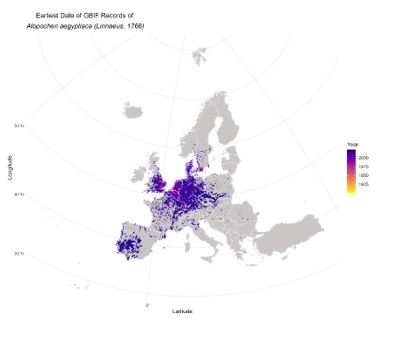You are viewing the Initial Version, the most recent version of this dataset.
1 version(s) available
Date of publication: August 22, 2024
Version 1
Date of publication: August 22, 2024
Type of change:
Description:

Occurrence Metrics for Invasive Alien Species of Union Concern in EU27: A 10 km prototype using GBIF occurrence cubes
by Lina Estupinan-Suarez
This dataset includes GBIF occurrences of species listed under Regulation (EU) 1143/2014 on invasive alien species (IAS). The IAS list, adopted in 2016 and updated in 2017, 2019, and 2022, currently includes 88 species subject to strict environmental restrictions.
For this study, we used the most recent IAS list from the European Topic Centre on Biodiversity and Ecosystems (ETC BE) and the European Environment Agency (EEA) as of June 2 ...(continue reading)
Citation
Estupinan-Suarez, L., Fernandez, M., Quoss, L., Oceguera, E. (2024). Occurrence Metrics for Invasive Alien Species of Union Concern in EU27: A 10 km prototype using GBIF occurrence cubes (Version 1) [Dataset]. German Centre for Integrative Biodiversity Research. https://doi.org/10.25829/w0vf54Invasive alien species of union concernEuropean UnionSpecies occurrenceBasis of recordCube occurrenceGBIF records
| Species | Genus | Family | Order | Class | Phylum | Kingdom |
|---|---|---|---|---|---|---|
| Acacia saligna | Acacia | Fabaceae | Fabales | Magnoliopsida | Tracheophyta | Plantae |
| Acridotheres tristis | Acridotheres | Sturnidae | Passeriformes | Aves | Chordata | Animalia |
| Ailanthus altissima | Ailanthus | Simaroubaceae | Sapindales | Magnoliopsida | Tracheophyta | Plantae |
| Alopochen aegyptiaca | Alopochen | Anatidae | Anseriformes | Aves | Chordata | Animalia |
| Alternanthera philoxeroides | Alternanthera | Amaranthaceae | Caryophyllales | Magnoliopsida | Tracheophyta | Plantae |
| Ameiurus melas | Ameiurus | Ictaluridae | Siluriformes | Chordata | Animalia | |
| Andropogon virginicus | Andropogon | Poaceae | Poales | Liliopsida | Tracheophyta | Plantae |
| Arthurdendyus triangulatus | Arthurdendyus | Geoplanidae | Tricladida | Platyhelminthes | Animalia | |
| Asclepias syriaca | Asclepias | Apocynaceae | Gentianales | Magnoliopsida | Tracheophyta | Plantae |
| Axis axis | Axis | Cervidae | Artiodactyla | Mammalia | Chordata | Animalia |
| Baccharis halimifolia | Baccharis | Asteraceae | Asterales | Magnoliopsida | Tracheophyta | Plantae |
| Cabomba caroliniana | Cabomba | Cabombaceae | Nymphaeales | Magnoliopsida | Tracheophyta | Plantae |
| Callosciurus erythraeus | Callosciurus | Sciuridae | Rodentia | Mammalia | Chordata | Animalia |
| Callosciurus finlaysonii | Callosciurus | Sciuridae | Rodentia | Mammalia | Chordata | Animalia |
| Cardiospermum grandiflorum | Cardiospermum | Sapindaceae | Sapindales | Magnoliopsida | Tracheophyta | Plantae |
| Cenchrus setaceus | Cenchrus | Poaceae | Poales | Liliopsida | Tracheophyta | Plantae |
| Corvus splendens | Corvus | Corvidae | Passeriformes | Aves | Chordata | Animalia |
| Ehrharta calycina | Ehrharta | Poaceae | Poales | Liliopsida | Tracheophyta | Plantae |
| Elodea nuttallii | Elodea | Hydrocharitaceae | Alismatales | Liliopsida | Tracheophyta | Plantae |
| Eriocheir sinensis | Eriocheir | Varunidae | Decapoda | Malacostraca | Arthropoda | Animalia |
| Faxonius limosus | Faxonius | Cambaridae | Decapoda | Malacostraca | Arthropoda | Animalia |
| Faxonius rusticus | Faxonius | Cambaridae | Decapoda | Malacostraca | Arthropoda | Animalia |
| Faxonius virilis | Faxonius | Cambaridae | Decapoda | Malacostraca | Arthropoda | Animalia |
| Fundulus heteroclitus | Fundulus | Fundulidae | Cyprinodontiformes | Chordata | Animalia | |
| Gambusia affinis | Gambusia | Poeciliidae | Cyprinodontiformes | Chordata | Animalia | |
| Gambusia holbrooki | Gambusia | Poeciliidae | Cyprinodontiformes | Chordata | Animalia | |
| Gunnera tinctoria | Gunnera | Gunneraceae | Gunnerales | Magnoliopsida | Tracheophyta | Plantae |
| Gymnocoronis spilanthoides | Gymnocoronis | Asteraceae | Asterales | Magnoliopsida | Tracheophyta | Plantae |
| Hakea sericea | Hakea | Proteaceae | Proteales | Magnoliopsida | Tracheophyta | Plantae |
| Heracleum mantegazzianum | Heracleum | Apiaceae | Apiales | Magnoliopsida | Tracheophyta | Plantae |
| Heracleum persicum | Heracleum | Apiaceae | Apiales | Magnoliopsida | Tracheophyta | Plantae |
| Heracleum sosnowskyi | Heracleum | Apiaceae | Apiales | Magnoliopsida | Tracheophyta | Plantae |
| Humulus scandens | Humulus | Cannabaceae | Rosales | Magnoliopsida | Tracheophyta | Plantae |
| Hydrocotyle ranunculoides | Hydrocotyle | Araliaceae | Apiales | Magnoliopsida | Tracheophyta | Plantae |
| Impatiens glandulifera | Impatiens | Balsaminaceae | Ericales | Magnoliopsida | Tracheophyta | Plantae |
| Koenigia polystachya | Koenigia | Polygonaceae | Caryophyllales | Magnoliopsida | Tracheophyta | Plantae |
| Lagarosiphon major | Lagarosiphon | Hydrocharitaceae | Alismatales | Liliopsida | Tracheophyta | Plantae |
| Lampropeltis getula | Lampropeltis | Colubridae | Squamata | Chordata | Animalia | |
| Lepomis gibbosus | Lepomis | Centrarchidae | Perciformes | Chordata | Animalia | |
| Lespedeza cuneata | Lespedeza | Fabaceae | Fabales | Magnoliopsida | Tracheophyta | Plantae |
| Lithobates catesbeianus | Lithobates | Ranidae | Anura | Amphibia | Chordata | Animalia |
| Ludwigia grandiflora | Ludwigia | Onagraceae | Myrtales | Magnoliopsida | Tracheophyta | Plantae |
| Ludwigia peploides | Ludwigia | Onagraceae | Myrtales | Magnoliopsida | Tracheophyta | Plantae |
| Lygodium japonicum | Lygodium | Lygodiaceae | Schizaeales | Polypodiopsida | Tracheophyta | Plantae |
| Lysichiton americanus | Lysichiton | Araceae | Alismatales | Liliopsida | Tracheophyta | Plantae |
| Microstegium vimineum | Microstegium | Poaceae | Poales | Liliopsida | Tracheophyta | Plantae |
| Muntiacus reevesi | Muntiacus | Cervidae | Artiodactyla | Mammalia | Chordata | Animalia |
| Myocastor coypus | Myocastor | Myocastoridae | Rodentia | Mammalia | Chordata | Animalia |
| Myriophyllum aquaticum | Myriophyllum | Haloragaceae | Saxifragales | Magnoliopsida | Tracheophyta | Plantae |
| Myriophyllum heterophyllum | Myriophyllum | Haloragaceae | Saxifragales | Magnoliopsida | Tracheophyta | Plantae |
| Nasua nasua | Nasua | Procyonidae | Carnivora | Mammalia | Chordata | Animalia |
| Prosopis juliflora | Prosopis | Fabaceae | Fabales | Magnoliopsida | Tracheophyta | Plantae |
| Nyctereutes procyonoides | Nyctereutes | Canidae | Carnivora | Mammalia | Chordata | Animalia |
| Ondatra zibethicus | Ondatra | Cricetidae | Rodentia | Mammalia | Chordata | Animalia |
| Oxyura jamaicensis | Oxyura | Anatidae | Anseriformes | Aves | Chordata | Animalia |
| Pacifastacus leniusculus | Pacifastacus | Astacidae | Decapoda | Malacostraca | Arthropoda | Animalia |
| Parthenium hysterophorus | Parthenium | Asteraceae | Asterales | Magnoliopsida | Tracheophyta | Plantae |
| Perccottus glenii | Perccottus | Odontobutidae | Perciformes | Chordata | Animalia | |
| Persicaria perfoliata | Persicaria | Polygonaceae | Caryophyllales | Magnoliopsida | Tracheophyta | Plantae |
| Pistia stratiotes | Pistia | Araceae | Alismatales | Liliopsida | Tracheophyta | Plantae |
| Pontederia crassipes | Pontederia | Pontederiaceae | Commelinales | Liliopsida | Tracheophyta | Plantae |
| Procambarus clarkii | Procambarus | Cambaridae | Decapoda | Malacostraca | Arthropoda | Animalia |
| Procambarus virginalis | Procambarus | Cambaridae | Decapoda | Malacostraca | Arthropoda | Animalia |
| Procyon lotor | Procyon | Procyonidae | Carnivora | Mammalia | Chordata | Animalia |
| Pseudorasbora parva | Pseudorasbora | Cyprinidae | Cypriniformes | Chordata | Animalia | |
| Pycnonotus cafer | Pycnonotus | Pycnonotidae | Passeriformes | Aves | Chordata | Animalia |
| Rugulopteryx okamurae | Rugulopteryx | Dictyotaceae | Dictyotales | Phaeophyceae | Ochrophyta | Chromista |
| Salvinia molesta | Salvinia | Salviniaceae | Salviniales | Polypodiopsida | Tracheophyta | Plantae |
| Sciurus carolinensis | Sciurus | Sciuridae | Rodentia | Mammalia | Chordata | Animalia |
| Sciurus niger | Sciurus | Sciuridae | Rodentia | Mammalia | Chordata | Animalia |
| Solenopsis invicta | Solenopsis | Formicidae | Hymenoptera | Insecta | Arthropoda | Animalia |
| Tamias sibiricus | Tamias | Sciuridae | Rodentia | Mammalia | Chordata | Animalia |
| Threskiornis aethiopicus | Threskiornis | Threskiornithidae | Pelecaniformes | Aves | Chordata | Animalia |
| Trachemys scripta | Trachemys | Emydidae | Testudines | Chordata | Animalia | |
| Triadica sebifera | Triadica | Euphorbiaceae | Malpighiales | Magnoliopsida | Tracheophyta | Plantae |
| Wasmannia auropunctata | Wasmannia | Formicidae | Hymenoptera | Insecta | Arthropoda | Animalia |
| Xenopus laevis | Xenopus | Pipidae | Anura | Amphibia | Chordata | Animalia |



